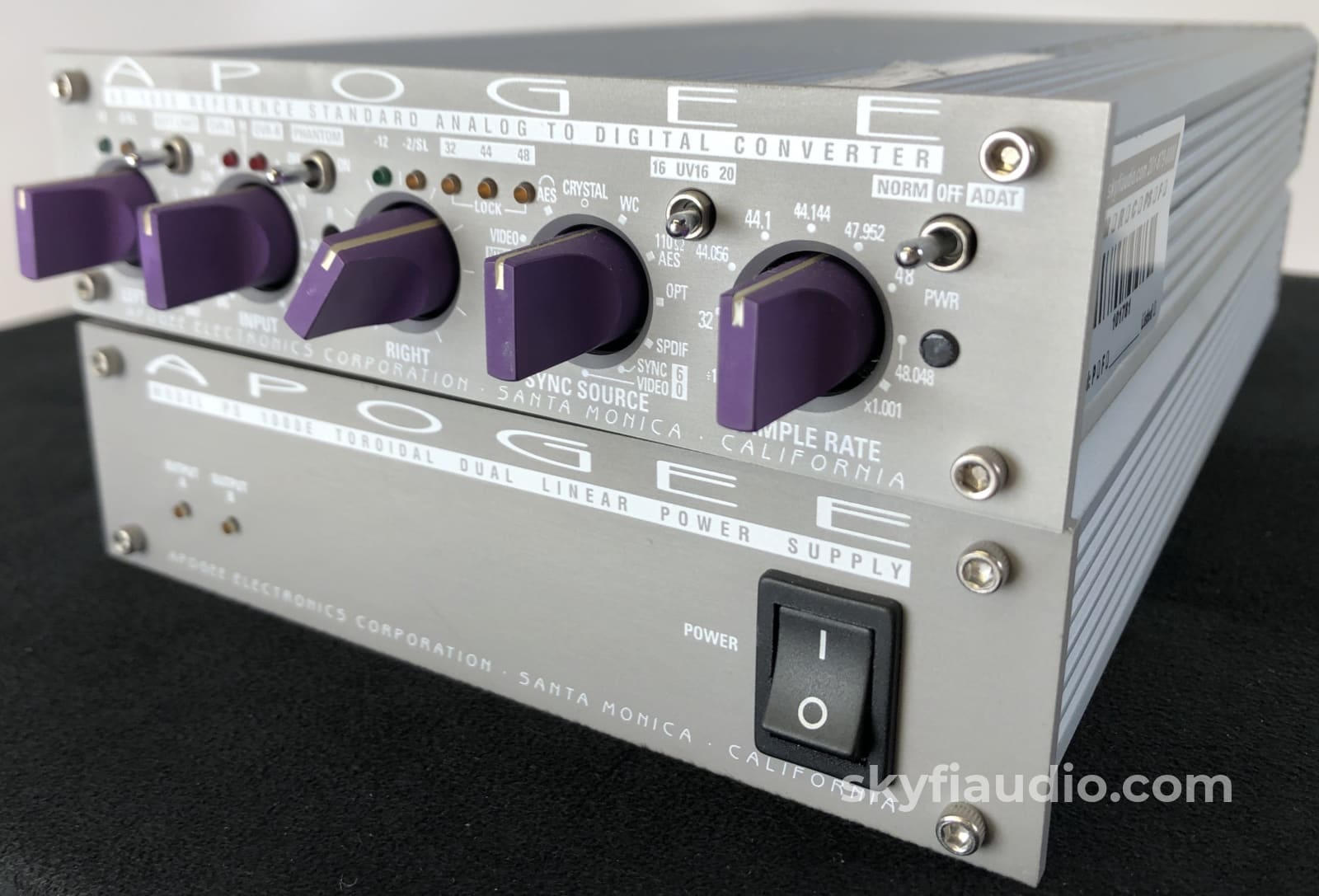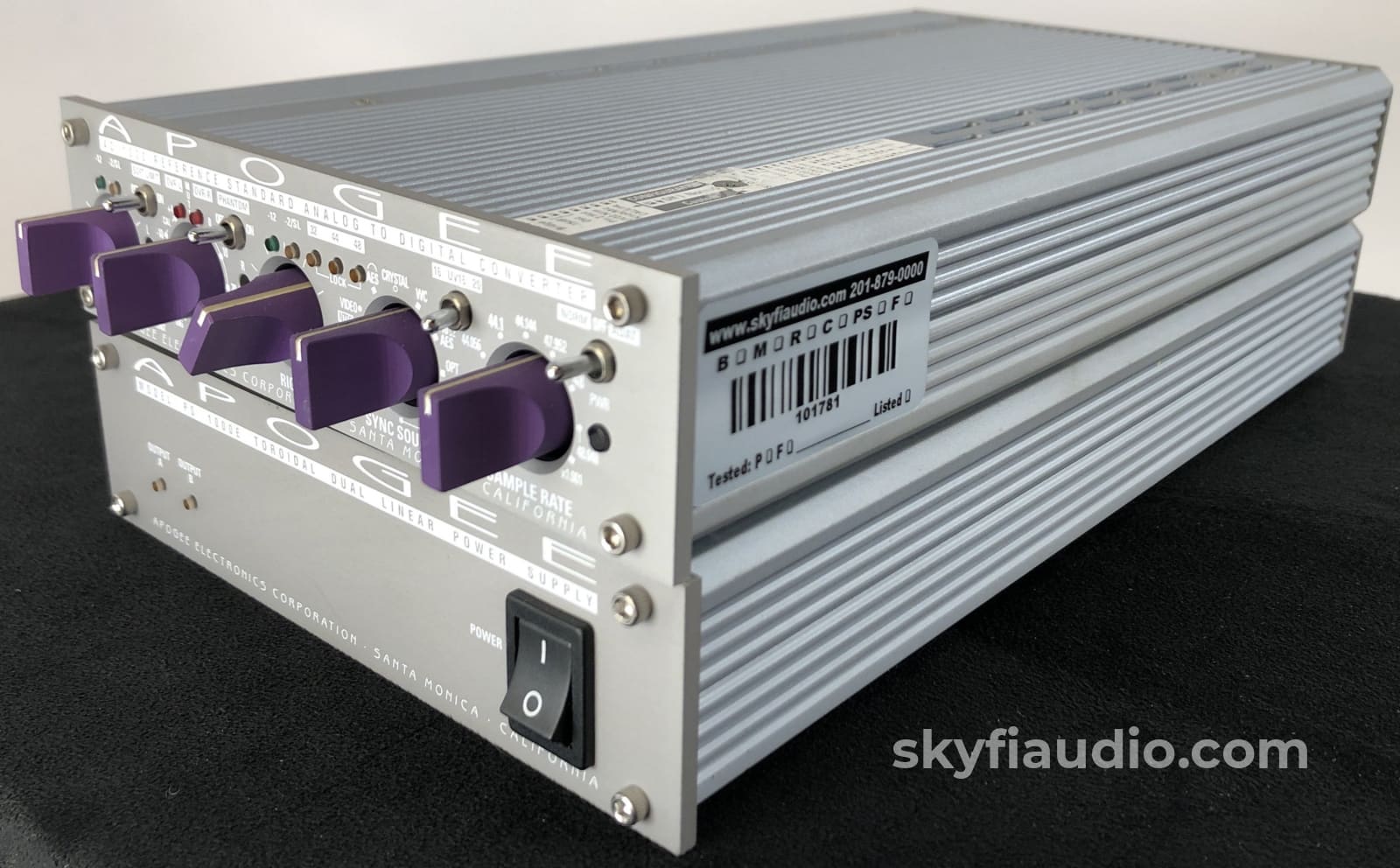








Apogee AD-1000 Reference Standard 20-bit Resolution A/D Converter with PS-1000E External Power Supply
Free Shipping on Most Electronics - Excludes Speakers and Items Requiring Freight - Contiguous U.S. Only
Pickup currently unavailable at SkyFi 479

Apogee AD-1000 Reference Standard 20-bit Resolution A/D Converter with PS-1000E External Power Supply
SkyFi 479
479 South Broad Street
Glen Rock NJ 07452
United States
List price for this back in the late 1990's/early 2000's was $3,295 - and that was without the external power supply.
“Your first class ticket from analog to digital!”
At Apogee we believe creating new products which really mean something requires putting a lot of one’s self into that product. Apogee’s AD-1000 was conceived and designed with a passion. The team who put it together put themselves into the product and the results show. We wanted the very best performance and most flexible capabilities – at a reasonable price. We took the pre-production units to the toughest critics, our friends in the mastering world, fussy mixing engineers, and picky end users. When we reached the point where they couldn’t reliably pick between the analog original and the AD-1000 digital output, we knew we had arrived at our goal: a transparent, unveiled digital reflection of the analog source. Up to that point we tweaked and honed the design for almost two years, keeping you and our other clients waiting while the perfectionist in us wouldn’t let go of the earlier designs. We know you will find the wait was worth it. Thanks for trusting Apogee – we are sure your new AD- 1000 will surpass your expectations and provide years of quality service.
The AD-1000 is a multi-purpose stereo analog to digital converter combining a high quality dual-stage, triple servo, analog ‘front end’ with 20 bit resolution. This combination provides unmatched sonic performance of 20 bit resolution, optimized for 20- and 16-bit applications such as digital tape recorders, disk-based audio work- stations, and CD premastering. The AD-1000 includes Apogee’s UV22® Encoding system, as used by mastering facilities worldwide to capture 20 bit detail in 16-bit formats such as CD and DAT.
Analog Input Circuitry
The AD-1000 features a proprietary balanced discrete front end with a combined noise and distortion measurement in the 0.001% range. The unit features XLR input connectors that will accept input levels from microphones and line levels up to +28 dBu. The common mode rejection is typically 100 dB – surpassing even the finest transformers – and provides very stable performance over a broad temperature range. Also incorporated, in front of the active circuitry, is a passive RF filter with hand-selected resistors and capacitors – matched to better than one part per thousand – to roll off any outside interference, without the typical intermodulation distortion byproducts of active circuitry.
Input Selector and Gain Controls
The input selector is an 11-position switch providing maximum input flexibility. When the switch is in the center MUTE position, the digital output still delivers a ‘digital black’ condition (all 0’s) used for sync in many master- ing and video applications. Rotating the selector clockwise, the next five positions select microphone input gain in 10 dB increments. Used in conjunction with the LEFT and RIGHT input level controls, up to 54 dB of gain is available (40 dB from the input selector and an additional 14 dB if the LEFT or RIGHT controls are fully clock- wise). This combination allows the setting of the coarse gain with the input selector and fine calibration using the LEFT and RIGHT controls. (Note: The LEFT and RIGHT controls can be bypassed and the gain can be rout- ed to the multi-turn CAL pots if desired. See page 31 for details of this procedure.)
Line Level Inputs +4 dBu and –10 dBV
Two CAL positions are available by rotating the INPUT SELECTOR counter-clockwise from twelve o’clock. These positions correspond to +4 (Pro) and –10 (Consumer) line level inputs. When either of these positions are selected, the multi-turn CAL trim pots are enabled. (Note: The CAL pots can be bypassed and the gain can be routed to LEFT and RIGHT controls if desired.
Phantom Power
48 volt phantom power is supplied to both microphone inputs when this selector is in the ON position and the input selector is in any MIC or the 12 o’clock mute position. The phantom voltage ramps up and down slowly for quiet activation and uses highly accurate resistors for optimum performance.
Soft Limit
Included with the AD-1000 is Apogee’s highly acclaimed Soft Limit circuitry. (This feature has functioned as many an engineer’s “secret weapon” to get extra level in their masters.) Soft Limit functions as a selective peak limiter. Typical peak limiters are very abrupt and can spread unwanted harmonics. With the AD-1000, once an input signal passes the threshold, Soft Limit gently removes the peaks by rounding them off, making the limiting action very difficult to hear. The result is ‘hotter’ sounding program material.
Filters
Apogee has long been known for filter technology – the result of years of proven, proprietary designs. The AD- 1000 continues this tradition with the ultimate in filter performance. A quadruple stage, progressive passive filter is inserted between the analog inputs and the analog to digital converter.
20 Bit Conversion and UV22
The AD-1000 resolves analog detail to the 20-bit level to capture accurately every subtle nuance of the analog input signal. The output can be either 20-bit resolution or 16-bit. Apogee’s UV22 Super CD Encoding system may be utilized when working with 16-bit recording formats. Used by virtually all major mastering facilities, UV22 captures the resolution and detail of the 20-bit conversion in a 16-bit word length; information that would normally be lost.
Sync Sources
It is unusual to use an analog to digital converter in a stand-alone environment. We have included every popular sync source capability via the ground-isolated BNC connectors (with additional loop through). Sync is selected via the front panel SYNC SOURCE SELECTOR SWITCH. Sync source capabilities include: CRYSTAL (selects the internal crystal reference from the sample rate switch); WORD CLOCK (locks to any external clock from 32 to 54KHz, including full vari-speed operation); AES/EBU, S/PDIF; VIDEO and SYNC (NTSC [525line/59.94Hz], Monochrome [525line/60Hz], PAL [625line/50Hz] are provided).
Sample Rate
An accurate 10 PPM internal crystal provides sample rates of 32, 44.1 and 48 KHz and the 0.1% derivatives 44.056, 44.144, 47.952 and 48.048 KHz (useful in film and video transfer work). The AD-1000 also has ability to multiply or divide incoming AES, S/PDIF, Optical and Word Clock sync by 1.001 for added flexibility. (1.001 is the ratio between monochrome video – originally used in mastering CD’s – and NTSC video.)
Metering
A simple but very effective LED metering system has been incorporated into the AD-1000 that indicates levels below converter clipping and is designed to be used with the hosts’ metering. The –12 LED for each channel can be customized. The –12 labeling is nominal; in fact the threshold of this LED is tied to the digital oscillator level and can be varied from –20 to –12 below 0dBfs. This is done by adjusting various switches on the top of the AD-1000. The –12/Threshold LEDs also serve an additional function. When a signal is within 0.05dB of the nominal gain of the AD-1000 oscillator setting, these LEDs flash rapidly. This is used to calibrate the analog to digital conversion levels.
When Soft Limit is engaged, the –2 LED acts as a Soft Limit Threshold indicator. When this threshold is achieved, the –2/SL will light. When Soft Limit is not engaged, the LED will signal when a peak of –2dBfs is achieved.
Two separate Red LEDs indicate “overs” (digital clipping) when three or more samples in a row reach “all ones”.
Digital Outputs
A separate transformer-isolated AES/EBU output is provided on the rear of the unit. Also provided is a fiber optic output connector which can supply either TOSLINK or ADAT format. S/PDIF and WORD CLOCK outputs are available on a high density 15-pin HD connector. (SDIF outputs are also optionally available on this connec- tor). Additionally, the WORD CLOCK output is driven by the internal Low Jitter Clock via a high speed opto- isolated driver.
AD-1000 Operating Manual Apogee Patented Low Jitter Clock
The C768 Ultra Low Jitter Slaving Clock references to an external clock source and provides a ‘flywheel’ effect by smoothing out short-term timing irregularities or jitter. This low jitter slaving clock locks in a predictable and very accurate phase relationship with the incoming reference. The result is superior sonic imaging with excel- lent soundstage detail. Whenever possible, the AD-1000 should be the digital timing source for the digital studio. Additional information on the sync capabilities of the AD-1000 is included on page 25 of this manual.
Please click here for detailed specifics regarding our specialized packing process that separates us from the rest.
|
Item |
Included |
|
Original Box |
No |
|
Manual |
Online |
|
Remote |
N/A |
|
Cables |
As Pictured + Power Cord |
|
Physical Condition |
7 |
|
Working Condition |
10 |
Choose options
